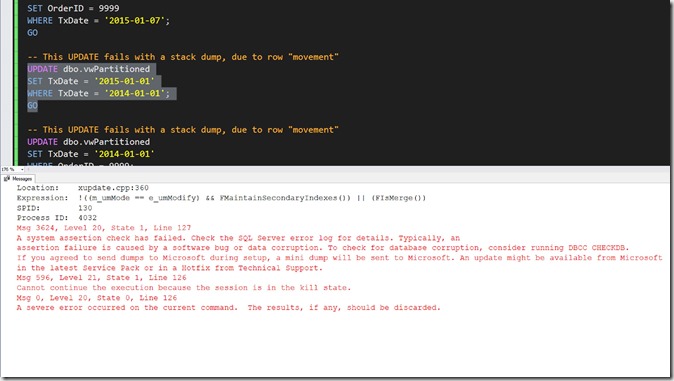As part of a conversation on the #sqlhelp, I was giving feedback to a member of the Microsoft Tiger team about how In-Memory OLTP might be improved. One of my responses was about implementing a hot/cold data solution, and Adam Machanic (b|t) responded, suggesting that partitioned views might work. I had already tested partitioned views and memory-optimized tables for queries, and confirmed that it worked as expected, but I had never tested DML for this combination of features.
Based on my new testing, I can state with confidence that partitioned view support for DML with memory-optimized tables will properly handle INSERT and DELETE operations, but some UPDATE operations might fail, and that failure occurs in a most ungraceful way. After verifying that this is an issue on SQL 2016 SP1/CU3 and SQL 2017 CTP2.1, I filed this Connect item. Microsoft has confirmed this issue, but has not yet determined how it will be fixed. For example, they could decide to disallow all UPDATEs when a memory-optimized table belongs to a partitioned view, or instead decide to support it under limited circumstances. I’ll update this post when I have more detail from Microsoft.
Let’s assume that we have two tables that belong to a partitioned view. Both tables can be memory-optimized, or one table can be memory-optimized, and the other on-disk.
Success condition
an UPDATE occurs to a row in a table, and the UPDATE does not change where the row would reside, i.e. does not cause it to “move” to another table, based on defined CONSTRAINTS
Failure conditions:
a. UPDATE occurs to a row in the memory-optimized table that causes it to move to either another memory-optimized table, or a on-disk table
b. UPDATE occurs to a row in the on-disk table that causes it to move to the memory-optimized table
The failure looks like this:
Repro script:
/*
Repro for UPDATEs on a partitioned view
*/
SET NOCOUNT ON
DROP VIEW IF EXISTS dbo.vwPartitioned;
GO
DROP TABLE IF EXISTS dbo.Table1;
GO
DROP TABLE IF EXISTS dbo.Table2;
GO
CREATE TABLE dbo.Table1
(
TxDate DATE
,OrderID INT
CONSTRAINT PK_Table1 PRIMARY KEY NONCLUSTERED (TxDate, OrderID)
)
--WITH (DURABILITY = SCHEMA_AND_DATA, MEMORY_OPTIMIZED = ON);
GO
CREATE TABLE dbo.Table2
(
TxDate DATE
,OrderID INT
CONSTRAINT PK_Table2 PRIMARY KEY NONCLUSTERED (TxDate, OrderID)
)
WITH (DURABILITY = SCHEMA_AND_DATA, MEMORY_OPTIMIZED = ON);
GO
INSERT dbo.Table1
(
TxDate
,OrderID
)
VALUES
('2014-01-01', 1)
,('2014-01-10', 2)
,('2014-03-15', 3)
,('2014-07-20', 4);
INSERT dbo.Table2
(
TxDate
,OrderID
)
VALUES
('2015-01-07', 5)
,('2015-02-10', 6)
,('2015-03-18', 7)
,('2015-10-28', 8);
GO
CREATE VIEW dbo.vwPartitioned
WITH SCHEMABINDING AS
(
SELECT
TxDate
,OrderID
FROM dbo.Table1
UNION ALL
SELECT
TxDate
,OrderID
FROM dbo.Table2
);
GO
SET STATISTICS IO ON;
GO
ALTER TABLE dbo.Table2
ADD CONSTRAINT CC_Table2_TxDate CHECK (TxDate >= '2015-01-01');
GO
ALTER TABLE dbo.Table1
ADD CONSTRAINT CC_Table1_TxDate CHECK (TxDate < '2015-01-01');
GO
ALTER VIEW dbo.vwPartitioned
WITH SCHEMABINDING AS
(
SELECT
TxDate
,OrderID
FROM dbo.Table1
UNION ALL
SELECT
TxDate
,OrderID
FROM dbo.Table2
);
GO
INSERT dbo.vwPartitioned
(
TxDate
,OrderID
)
VALUES
('2014-01-13', 91)
,('2015-01-08', 85);
GO
UPDATE dbo.vwPartitioned
SET OrderID = 2
WHERE TxDate = '2014-01-13';
GO
DELETE dbo.vwPartitioned
WHERE TxDate = '2014-01-13';
GO
-- check location of rows
SELECT *
FROM dbo.Table2
ORDER BY OrderID
GO
SELECT *
FROM dbo.Table1
ORDER BY OrderID
GO
-- This UPDATE succeeds, because it does NOT attempt to "move" the row to another table
UPDATE dbo.vwPartitioned
SET OrderID = 9999
WHERE TxDate = '2015-01-07';
GO
-- This UPDATE fails with a stack dump, due to row "movement"
UPDATE dbo.vwPartitioned
SET TxDate = '2015-01-01'
WHERE TxDate = '2014-01-01';
GO
-- This UPDATE fails with a stack dump, due to row "movement"
UPDATE dbo.vwPartitioned
SET TxDate = '2014-01-01'
WHERE OrderID = 9999;
GO
-- check location of rows
SELECT *
FROM dbo.Table2
ORDER BY OrderID
GO
SELECT *
FROM dbo.Table1
ORDER BY OrderID
